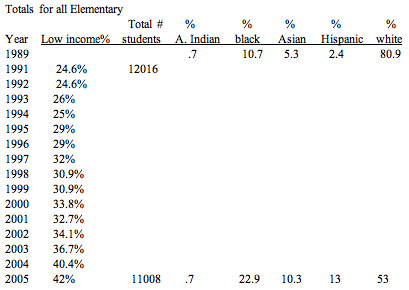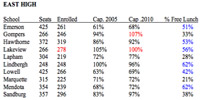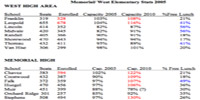While viewing the MMSD web site I came across some data called District data profile that suprised me, and answered some of my questions concerning low income disparity. While sitting on the task force, I have been bothered by the districts solution for dealing with high numbers of low income students by rearranging school boundaries and/or paring schools, and wondered if you really solved the disparity issue or if you shifted the issue to another school or something that would have to be solved at another time.
Madison school district low income percentages per www.mmsd.org 1991 – 2005.
 |
|
 |
 |
| East High 2005 – 2010 Elementary Projections (click to view a larger version) | Memorial/West 2005 – 2010 Elementary Projections (click to view a larger version) |
In 13 years, 1992 to 2005, MMSD low income percentage has gone from 24.6% to 42%.
- Has the definition of low income changed during this time period?
- Has the community as a whole really changed this much in 13 years?
As a community member that hears and believes there is no low income housing, where do these people live if 42% of our community is now low income? - We have lost 1000 elementary students in the same time period and doubled our minority students. Is this a wave of low births or are we losing students?
Middle School totals
- In 1991 there were 4776 students with a 20.3% low income.
- In 2005 there are 5297 students with a 38.6% low income.
High School totals
- In 1991 there were 6435 students with a 12% low income.
- In 2005 there are 8429 students with a 28% low income.
The question about pairing two schools and whether it improves low income percentage numbers over time was also in the data.
- Lincoln in 1991 was at 51% low income, 1997 59%, and 2005 69%.
- Midvale in 1991 was 42% low income, and 2005 it is at 64%.
It does not seem to have improved the high percentage of low income numbers.

My question regarding low income percentages continues to be: So What?!
What does that have to do with the ability or even to cost needed to teach kids the basic academic skills? My answer is nothing.
The continual citations of low income, minority, boys, girls and the continual excuses for failing by the district to give these kids (and all other kids) a good (not even a first rate) education is purely diversionary.
I would agree witht he comment that this should not affect the ability to teach these or any other students. However, the price issue does have some merit. The more low income students in the system, the more lunch and breakfast subsidies will cost. I would be interested to learn why the percentages have increased, especially since the federal “poverty line” has not increased with inflation. Meaning you have to be worse off to be considered impoverished now, than you did in the past. However, it is important to keep in mind that Madison schools are still among the best in the state and country. While they can be improved, it is not like we are talking about Little Rock or District of Columbia schools.
In addition to free/reduced lunches, the costs of educating impoverished kids really have to do with the additional resources that are needed in order to achieve a successful result. These kids tend to have a lot of barriers to academic success and tend to need more support and services from social workers, psychologists, reading teachers, etc. in order to be successful students. This is in addition to the small class sizes that help improve academic achievement.
I would like to respond to some of the points made by the original author and also some of the comments:
The low income percentage reflects the school population, not the overall adult population in Madison. This is signifiant because it indicates that more low income families send their children to public schools (use the system) than middle to high income families, hence the loss of enrollment over the years.
It also means that we cannot depend upon middle-high income families to be there to subsidize school budgets with fund raising, classroom help and all the other ways that they tend to contribute more than low income families. It also means that we need to change our ways of teaching for the same expectations (don’t dumb down because kids are low income). Assume that all kids can learn, but that not everyone has a personal computer at his/her disposal to complete the asignment. We need laptops to sign out to families the same way books are .
Rather than concentrate on income, we need to start assessing resources. What resources are needed for academic success, and how do we distribute them?